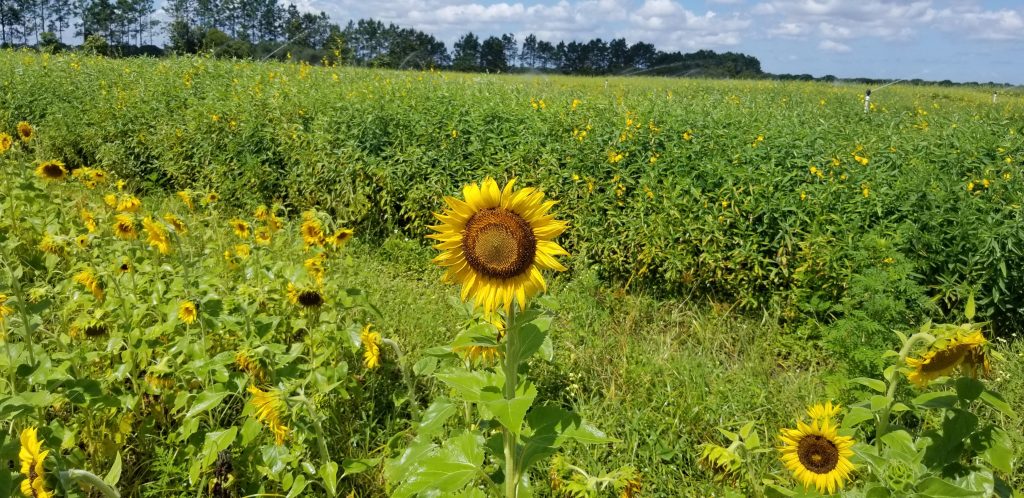
By Johan Desaeger
Cover crops are one of the more practical options for nematode management as their use is already common practice for many growers. The subtropical climate in Florida and the southeastern United States allows growers to plant crops year-round, and cover crops have been an important component of Florida’s agro-ecosystems since its early days of agriculture.
Until the 1930s, velvetbean was a popular summer cover crop in Florida due to its nitrogen contribution. However, around the 1950s when chemical fertilizers and pesticides became widely available, cover crops became less common. Currently, the most planted summer cover crops in Florida are sorghum-sudangrass hybrids, sunn hemp (Crotalaria juncea) and cowpea (Vigna unguiculata).
SUMMER COVER CROPS
Sorghum-sudangrass is a tall annual grass that is quite competitive against weeds. Leaf tissue of sorghum-sudangrass contains dhurrin, a cyanogenic glucoside that releases hydrogen cyanide upon degradation in the soil. While many varieties suppress root-knot nematodes (RKN) — by far the most damaging nematodes in Florida vegetables — sorghum-sudan is a good host to sting and stubby root nematodes. Sting nematodes are a major problem in Florida strawberries.
Sunn hemp is a tall, rapid-growing legume that is widely grown in tropical regions as a green manure. In Florida, Tropic Sun sunn hemp produces high amounts of biomass. Its ability to fix nitrogen permits vigorous growth, even in sandy soils with low levels of nitrogen. Sunn hemp is well known to be a poor host to RKN and also to sting nematodes. However, it is a good host to lesion nematodes. Sunn hemp also contains alkaloids in its tissue, and both its leaf and root residue have nematicidal activity.
Cowpea is a good fit as a summer cover crop for Florida growers. Unfortunately, cultivars like Iron Clay, which is the most common in Florida, is a good host to most species of RKN. Cowpea nematode susceptibility is greatly influenced by cultivar and composition of the nematode population. For example, while Iron Clay is a good host to most RKN species, California Blackeye No. 5, Tennessee Brown and Mississippi Silver are poor hosts to RKN. Both Iron Clay and Mississippi Silver can be good hosts for sting nematodes. In addition, cowpea is susceptible to southern blight, to which many Florida vegetables are also susceptible.
WINTER COVER CROPS
Common winter cover crop species include winter rye, oat, crimson clover, hairy vetch and several Brassica species such as mustard. These have varying effects on nematodes, but generally, when a susceptible crop is grown after them, nematode numbers quickly rebound. Brassica plants like mustard and radish are also known to have biofumigant properties. This is due to the glucosinolates (sulfur-containing compounds) that they contain. Upon degradation, glucosinolates hydrolyze into several volatile compounds, including isothiocyanates (the active component of metam-based soil fumigants) and mustard oils.
MIXING AND USE
Cover crops can be sown as a monoculture or as a mix of multiple species. Mixing cover crops with opposing nematode host status can have benefits in terms of nematode management. Previous cover crop experiments by the author in Kenya, involving a mixture of good RKN hosts with poor hosts similar to sunn hemp, created a more diverse nematode population, reduced nematode damage and increased yield of an RKN-susceptible crop in rotation.
The lack of nematode-specific data combined with the multitude of RKN (more than 15) and other nematode species in Florida warrants exploring the host status of cover crops (including cultivars) to each species of root-knot nematode. This is tedious work that takes time. However, such information would help growers to select appropriate cover crops, including mixtures that are tailored according to the resident nematode population of a field.
Properly managed, cover crops improve soil quality and health. They may impact soil nematodes in different ways, by limiting nematode reproduction during cover crop growth in the case of poor hosts, and by directly killing them via production of nematicidal compounds following incorporation of the biomass. In addition, by increasing soil organic matter, which is especially important in the poor sandy soils typical of Florida, cover crops can improve soil health by stimulating biological control organisms that are natural enemies of nematodes.









